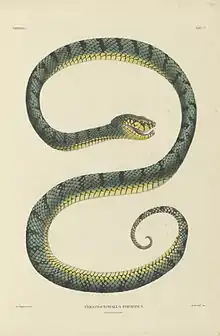Trimeresurus sumatranus
Trimeresurus sumatranus is a venomous pitviper species found in Thailand, Malaysia and Indonesia. Arboreal, its coloration is pale green with a red tail. Common names include Sumatran pitviper,[4] Sumatran tree viper,[5] and Sumatran pit viper.[6]
_(8741684078).jpg.webp)
| Trimeresurus sumatranus | |
|---|---|
 | |
| Scientific classification | |
| Kingdom: | Animalia |
| Phylum: | Chordata |
| Class: | Reptilia |
| Order: | Squamata |
| Suborder: | Serpentes |
| Family: | Viperidae |
| Genus: | Trimeresurus |
| Species: | T. sumatranus |
| Binomial name | |
| Trimeresurus sumatranus (Raffles, 1822) | |
| Synonyms | |
| |
Description
Trimeresurus sumatranus is a large heavy-bodied pitviper, with a prehensile tail. Adults may attain 1.6 metres (5 feet 3 inches) SVL (snout–vent length), with fangs over 10 mm (⅜ inch) long.[7]
It is an arboreal species that is pale green in color with a red tail.[5] The dorsal scales are edged with black, which may form crossbands in more mature specimens. There is a white or yellow stripe on each side along the first row of dorsal scales. Ventrally it is greenish or yellowish, and the ventral scales may be thinly edged with black.[8]
Scalation includes 21 (23) rows of dorsal scales at midbody, 183–190/182–191 ventral scales in males/females, 57–66/55–64 subcaudal scales in males/females, and 8–10 supralabial scales.[4]
Geographic range
Found in southern Thailand, West and East Malaysia (Sabah and Sarawak on Borneo) and Indonesia (Bangka, Billiton, Borneo, Sumatra and the nearby islands of Simalur, Nias, and possibly the Mentawai Islands [Sipora]). The type locality given is "Sumatra."[2]
According to Gumprecht et al. (2004), the records regarding its occurrence in the Mentawai Islands are probably based on T. hageni.[4]
Venom
Because it is a large snake with large fangs, Trimeresurus sumatranus can inject large quantities of venom. Fatalities from its bite have been reported, and it should be considered extremely dangerous.[7]
References
- Inger, R.F.; Grismer, L.; Chan-Ard, T. (2013). "Parias sumatranus". IUCN Red List of Threatened Species. 2013: e.T178274A44273835. doi:10.2305/IUCN.UK.2013-1.RLTS.T178274A44273835.en. Retrieved 10 January 2020.
- McDiarmid RW, Campbell JA, Touré T. 1999. Snake Species of the World: A Taxonomic and Geographic Reference, Volume 1. Herpetologists' League. 511 pp. ISBN 1-893777-00-6 (series). ISBN 1-893777-01-4 (volume).
- Trimeresurus sumatranus at the Reptarium.cz Reptile Database
- Gumprecht A, Tillack F, Orlov NL, Captain A, Ryabov S. 2004. Asian Pitvipers. Geitje Books. Berlin. 1st Edition. 368 pp. ISBN 3-937975-00-4.
- Mehrtens JM. 1987. Living Snakes of the World in Color. New York: Sterling Publishers. 480 pp. ISBN 0-8069-6460-X.
- Brown JH. 1973. Toxicology and Pharmacology of Venoms from Poisonous Snakes. Springfield, Illinois: Charles C. Thomas. 184 pp. LCCCN 73-229. ISBN 0-398-02808-7.
- Das, Indraneil. 2006. A Photographic Guide to Snakes and Other Reptiles of Borneo. Ralph Curtis Books. Sanibel Island, Florida. 144 pp. ISBN 0-88359-061-1. (Parias sumatranus, p. 55.)
- Boulenger, G.A. 1896. Catalogue of the Snakes in the British Museum (Natural History). Volume III., Containing the...Viperidæ.. Trustees of the British Museum (Natural History). (Taylor and Francis, Printers.) London. xiv + 727 pp. + Plates I.- XXV. (Lachesis sumatranus, pp. 557-558.)
Further reading
- Raffles, T.S. 1822. Second Part of the Descriptive Catalogue of a Zoological Collection made in [sic] the Island of Sumatra and its vicinity. Transactions of the Linnean Society of London 13 (2): 277-340. (Coluber sumatranus, p. 334.)
